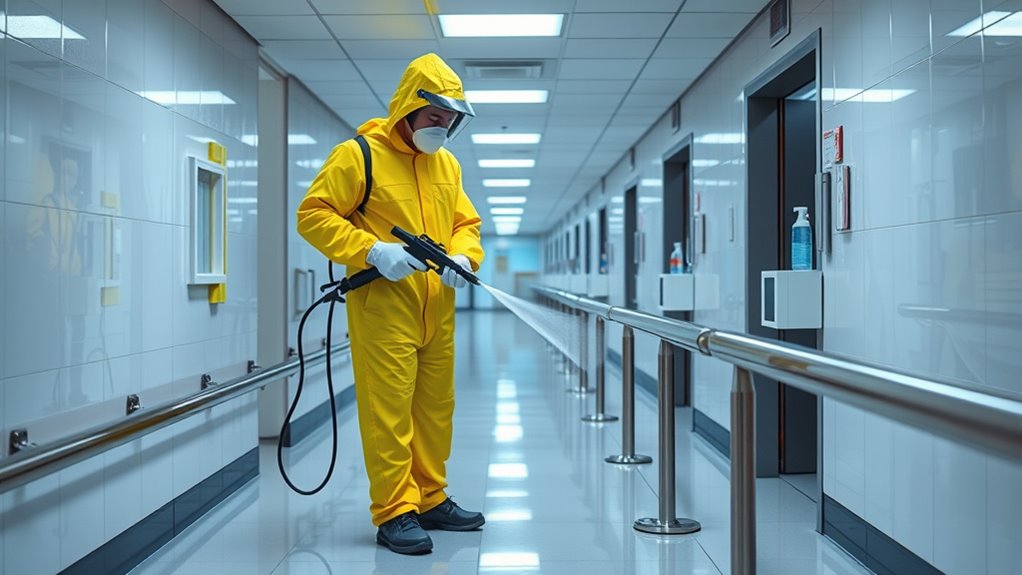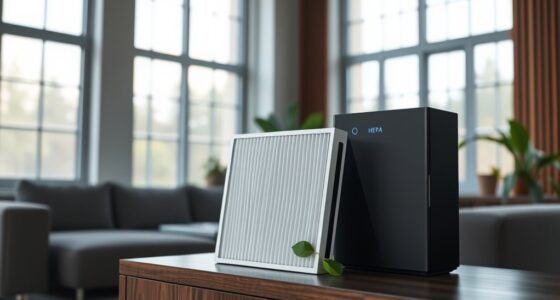To build pandemic resilience, you should prioritize rigorous cleaning and hygiene practices. Regularly disinfect high-touch surfaces, wash your hands often with soap and water, and avoid touching your face. Communities can support this by promoting sanitation initiatives and maintaining proper disinfection protocols in public spaces. Staying vigilant with personal habits and community efforts helps prevent future outbreaks. Keep exploring ways to strengthen these practices to stay protected and prepared for the challenges ahead.
Key Takeaways
- Regular disinfection of public spaces and high-touch surfaces reduces pathogen transmission risks.
- Promoting personal hygiene practices, such as handwashing and face-touching avoidance, enhances individual and community resilience.
- Implementing community sanitation protocols and automated cleaning systems ensures consistent hygiene standards.
- Effective communication and training enable rapid response and adherence to cleaning guidelines during outbreaks.
- Supporting community-led hygiene initiatives fosters a culture of vigilance and collective prevention efforts.

Have you ever wondered what makes some communities bounce back stronger after a pandemic? It often boils down to how well they prioritize personal hygiene and community preparedness. When you focus on maintaining good personal hygiene, you’re not just protecting yourself—you’re helping to prevent the spread of germs that can lead to outbreaks. Simple practices like washing your hands regularly with soap and water, avoiding touching your face, and covering your mouth when coughing or sneezing can make a big difference. These habits reduce the chances of transmitting viruses within your household and your community at large. But personal hygiene alone isn’t enough. Community preparedness plays a key role in safeguarding everyone. When communities invest in education campaigns, proper sanitation facilities, and clear communication channels, they create an environment where everyone understands their role in disease prevention.
Prioritizing personal hygiene and community preparedness strengthens pandemic resilience for healthier communities.
Being prepared means more than stockpiling supplies; it involves fostering a culture of cleanliness and awareness. Local authorities can provide resources and guidance on cleaning protocols, ensuring public spaces and high-touch surfaces are disinfected regularly. This proactive approach minimizes the risk of contamination and helps contain potential outbreaks before they escalate. As an individual, you can contribute by practicing consistent cleaning routines at home and encouraging others to do the same. Schools, workplaces, and public facilities should implement strict hygiene standards and educate people about the importance of disinfecting shared spaces. When everyone understands how personal hygiene and community efforts work hand-in-hand, it creates a resilient network that can withstand health crises. Additionally, leveraging Automation’s role in business intelligence can help optimize sanitation management and monitor compliance more effectively.
Community preparedness also involves having plans in place to respond swiftly to emerging threats. This includes establishing effective communication systems, training personnel on sanitation procedures, and ensuring access to sanitation supplies like hand sanitizers and disinfectants. When communities are ready, response times improve, and the spread of infection is curbed more efficiently. You play an essential part here by staying informed about local health advisories and practicing recommended hygiene measures consistently. The more you contribute to a culture of cleanliness and preparedness, the stronger your community becomes.
In the end, pandemic resilience hinges on collective effort. You can influence this by adopting good personal hygiene habits and supporting community initiatives aimed at maintaining sanitation standards. When everyone participates, communities can recover quicker, reduce the impact of future outbreaks, and emerge healthier and more united. It’s a continuous process of vigilance, education, and action that guarantees everyone’s safety, now and in the future.
Frequently Asked Questions
How Often Should High-Touch Surfaces Be Disinfected?
You should disinfect high-touch surfaces at least daily, especially in busy areas. Keep hand hygiene practices in mind by washing your hands regularly and using sanitizer. Also, guarantee proper air filtration to reduce airborne pathogens. Regular cleaning combined with good hand hygiene and effective air filtration creates a safer environment, lowering the risk of disease transmission and helping prevent future outbreaks. Stay consistent to maintain a healthier space.
What Cleaning Products Are Most Effective Against Viruses?
Think of your cleaning routine as a shield in a battle against invisible enemies. Use products with proven antiviral agents, like EPA-registered disinfectants, to guarantee maximum disinfectant efficacy. These powerful cleaners break down virus structures, protecting your space. Always follow label instructions for proper contact time. By choosing effective disinfectants, you strengthen your defenses, creating a safer environment and turning your cleaning efforts into a victorious act of resilience.
How Can Cleaning Routines Be Adapted for Crowded Public Spaces?
You can adapt cleaning routines for crowded public spaces by focusing on crowd density management and ventilation improvements. Regularly disinfect high-touch surfaces, especially in areas with high traffic, and increase the frequency of cleaning during peak times. Guarantee proper ventilation to reduce airborne virus particles, and encourage social distancing. These steps, combined with targeted cleaning, help minimize infection risks and keep public spaces safer for everyone.
Are There Eco-Friendly Disinfectants That Still Ensure Safety?
Yes, you can use eco-friendly disinfectants that still guarantee safety. Look for green chemicals and biodegradable options, which effectively kill germs without harmful chemicals. These products are designed to be safe for people and the environment, making them ideal for regular cleaning. By choosing biodegradable disinfectants, you reduce your ecological footprint while maintaining high standards of hygiene, helping prevent future outbreaks responsibly.
What Training Is Necessary for Staff to Implement Best Cleaning Practices?
Think of staff education as planting seeds for a safer environment. You need clear training protocols that teach proper cleaning techniques, disinfectant usage, and safety measures. Hands-on demonstrations and regular refreshers help staff stay sharp, turning routine cleaning into a shield against outbreaks. By investing in thorough training, you empower your team to act confidently and consistently, transforming your space into a fortress of health and resilience.
Conclusion
Just like Odysseus charting treacherous waters, your commitment to proper cleaning practices keeps you resilient against future outbreaks. By staying vigilant and maintaining hygiene, you’re building a fortress of protection around yourself and those around you. Remember, every small effort adds a brick to the wall of pandemic resilience. Stay proactive, stay safe—your actions today echo the wisdom of those who fought to return home, stronger and wiser for it.









